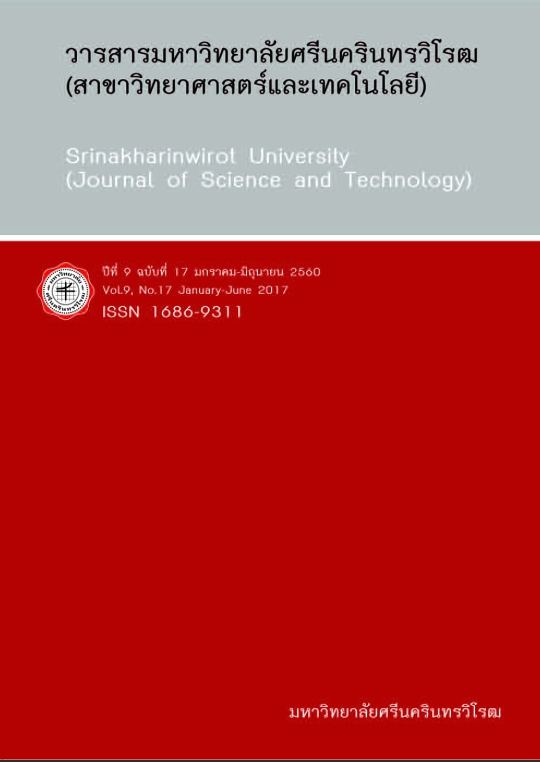ผลของกระบวนการแปรรูปที่แตกต่างกันต่อปริมาณสารประกอบฟีนอลิก ปริมาณแอนโธไซยานิน ความสามารถในการต้านอนุมูลอิสระ และการยอมรับ จากผู้บริโภคของผลิตภัณฑ์ชาใบข้าวก่ำ EFFECT OF DIFFERENT PROCESSING ON PHENOLIC CONTENT, ANTHOCYANIN CONTENT, ANTIOXIDANT CAPACITY
Keywords:
Black Glutinous Rice Leaves Tea, Anthocyanin, Antioxidant Capacity, Consumer AcceptanceAbstract
บทคัดย่อ
ข้าวก่ำหรือข้าวเหนียวดำ (Oryza sativa L.) เป็นข้าวพันธุ์พื้นเมืองของไทย ปลูกมากในภาคเหนือและภาคตะวันออกเฉียงเหนือของประเทศไทย ใบของข้าวก่ำมีสีม่วงหรือดำ และอาจพบว่ามีสารต้านอนุมูลอิสระ เช่น คลิโนโลน อัลคาลอยด์ วิตามินอี โพลีฟีนอล และแอนโธไซยานิน ชาใบข้าวมักผลิตจากใบข้าวอ่อนอายุ 15-20 วัน ซึ่งมีจำหน่ายทั่วไป แต่ไม่พบว่ามีผลิตภัณฑ์ชาจากใบข้าวก่ำจำหน่ายในท้องตลาด งานวิจัยนี้จึงมุ่งเน้นผลของกระบวนการแปรรูปที่แตกต่างกันต่อการพัฒนาผลิตภัณฑ์ชาจากใบข้าวก่ำโดยศึกษาถึงความชื้น สี ผลของปริมาณแอนโทไซยานิน ความสามารถในการต้านอนุมูลอิสระ และการยอมรับของผู้บริโภค ผลที่ได้พบว่ากระบวนการแปรรูปที่แตกต่างกันมีผลต่อปริมาณความชื้นของใบชาข้าวก่ำ โดยความชื้นต่ำสุดของใบชาข้าวก่ำพบในกระบวนการคั่วที่อุณหภูมิ 175 องศาเซลเซียส 5 นาที (ปริมาณความชื้นร้อยละ 2) กระบวนการแปรรูปที่แตกต่างกันมีผลต่อสีของทั้งใบชาข้าวก่ำและน้ำชาใบข้าวก่ำ กระบวนการแปรรูปโดยการอบ และการคั่ว ไม่มีความแตกต่างอย่างมีนัยสำคัญต่อปริมาณปริมาณสารประกอบฟีนอลิก ปริมาณแอนโธไซยานินในใบชาข้าวที่ผ่านการทำแห้งด้วยตู้อบทั้งสองสภาวะ ที่อุณหภูมิ 50 และ 60 องศาเซลเซียส นาน 24 ชั่วโมง พบว่ามีค่าเท่ากับ 2.34 และ 1.34 มิลลิกรัมต่อลิตร ตามลำดับ ซึ่งปริมาณแอนโธยานินที่พบนี้มีปริมาณสูงกว่าปริมาณของแอนโธไซยานินในใบชาข้าวที่ผ่านการคั่วที่ 175 และ 250 องศาเซลเซียส นาน 5 นาที (ปริมาณแอนโธไซยานินเท่ากับ 0.52 และ 0.11 มิลลิกรัมต่อลิตร ตามลำดับ) อย่างไรก็ตามความสามารถในการต้านอนุมูลอิสระโดยวิธี DPPH ลดลงอย่างมีนัยสำคัญเมื่ออุณหภูมิในการแปรรูปเพิ่มขึ้น (P < 0.05) ผู้ทดสอบชิมชอบน้ำชาจากใบชาข้าวก่ำที่ผ่านการแปรรูปโดยการคั่วทั้งสองสภาวะมากกว่าการแปรรูปโดยการอบทั้งสองสภาวะ
Abstract
Khao Kham or black glutinous rice (Oryza sativa L.) is a traditional Thai rice, grown mainly in northern and north eastern Thailand. The glutinous rice leaf is coloured purple or black and may contain antioxidants such as quinolone alkaloid, vitamin E, polyphenol and anthocyanin. Rice leaf tea made from 15-20 day old leaves has already been commercially available. However no such product as rice leaf teas made from the purple glutinous rice leaf has been found in the market. This research focused on the effects of different processing on the product development of tea from black glutinous rice leaves, in particular moisture content, colour, anthocyanin content, antioxidant capacities and consumer acceptance. Results showed that the different processes had an effect on the moisture content of black glutinous rice leaves. The lowest moisture content of rice leaf tea has been found in panning at 175 degrees centigrade for 5 min (M.C. = 2%). There was an effect from the different processes on the colour of both the black glutinous rice leaf and the black glutinous rice leaf tea. There was no significant effect from the oven and panning processes on phenolic contents. The anthocyanin content was discovered at a greater quantity in the leaves after they have been dried in an oven at two separate temperatures (50 degrees centigrade and 60 degrees centigrade), each for 24 hours (2.34 mg/L and 1.34 mg/L respectively). This quantity of anthocyanin is higher than the quantities found in the leaves after panning them in two separate processes than the two panning processes at 175 degrees centigrade for 5 minutes and 250 degrees centigrade for 5 minute (the resulting amounts were 0.52 and 0.11 mg/L of anthocyanin content, respectively.) However, antioxidant activities by a DPPH method were found to be significantly decreased while increasing the process temperature (P < 0.05). The panelists preferred the back, glutinous rice leaf tea produced by the two panning methods over those produced by the two drying processes.
Downloads
Downloads
Published
How to Cite
Issue
Section
License
Srinakharinwirot University Journal of Sciences and Technology is licensed Under a Creative Commons Attribution-NonCommercial-NoDerivs 4.0 International (CC-BY-NC-ND 4.0) License, Unless Otherwise Stated. Please Read Journal Policies Page for More Information on Open Access, Copyright and Permissions.



